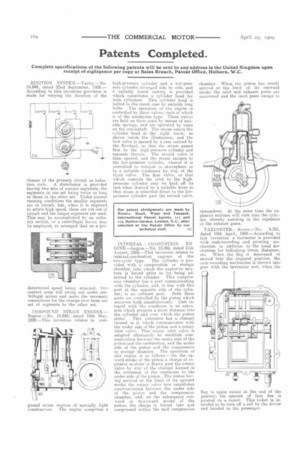Patents Completed.
Page 20

If you've noticed an error in this article please click here to report it so we can fix it.
Complete specifications of the following patents will be sent to any address in the United Kingdom upon receipt of eightpence per copy at Sales Branch, Patent Office, Holborn, W.C.
IGNITMN SYSTEM.—Varley.—No. 19,849, dated 22nd September, 1908.— According to this invention provision is made for varying the duration of the closure of the primary circuit in induc tion coils. A distributor is provided having two sets of contact segments, the segments in one set being twice as long as those in the other set. Under normal running conditions the smaller segments are in circuit, but, when it is required to attain high speed, these are cut out of circuit and the longer segments are used. This may be accomplished by an ordinary switch, or a centrifugal device may be employed, so arranged that on a pie determined speed being attained, two contact arms will swing out under centrifugal action and make the necessary connections for the change over from one set of segments to the other set.
COMPOUND STEAM ENGINENapier.—No 10,849, dated 19th May, 1908.—This invention relates to corn pound steam engines of specially light construction. The engine comprises a
high-pressure cylinder and a low-pressure cylinder arranged side by side, and a suitably bored casting is provided which constitutes a cylinder head for both cylinders. This cylinder head is bolted to the crank case by suitable long bolts. The operation of the engine is controlled by three valves, each of which is of the mushroom type. These valves are held on their seats by means of suitable springs, and are operated by cams on the crankshaft. The steam enters the cylinder head at the right hand, as shown inside the illustration, and the first valve is opened by a cam carried by the flywheel, so that the steam passes first to the high-pressure cylinder and expands therein. The second valve is then opened, and the steam escapes to the low-pressure cylinder, whence it is Permitted to exhaust to atmosphere or to a suitable condenser by way of the third valve. The first valve, or that which controls the inlet to the highpressure cylinder may he held off its seat when desired by a suitable lever so that steam is admitted direct to the lowpressure cylinder past the second valve.
INTERNAL COMBUSTION EN GINE.—Legros.—No. 18,866, dated 11th August, 1908.—This invention relates to internal-combustion engines of the
two-cycle type. The cylinder is provided with a compression or storage chamber, into which the explosive mixture is forced prior to its being ad. rnitted to the cylinder. This compressioii chamber has a port communicating with the cylinder, and, in line with this port at the opposite side of the cylin
der, is an exhaust port. Both these ports are controlled by the piston which uncovers both simultaneously. Cast integral with the crankcase is an extension which projects a short distance into the cylinder and over which the piston
slides. This extension has a channel formed in it which communicates with the under side of the piston and a rotary inlet valve. This rotary inlet valve is adapted alternately to establish communication between the under side of the piston and the crirbiaretter, and the under side of the piston and the compression or storage chamber. The operation of this engine is as follows :--On the upward stroke of the piston a charge of explosive mixture is drawn past the rotary valve by way of the channel formed in the extension of the crankcase to the -under side of the piston. The piston hay• ing arrived at. the limit of its upward stroke the rotary valve now establishes communication between the under side of the piston and the compression chamber, and, on the subsequent outward or downward stroke of the piston. the charge is forced into and compressed within the said compression
chamber. When the piston has nearly arrived at the limit of its outward stroke the inlet and exhaust ports are uncovered and the inert gases escape to atmosphere. At the same time the explosive mixture will rush into the cylinder, thereby assisting in the expulsion of the exhaust gases.
TAXI M ETER.—Reene.—No. 8,391, dated 15th April, 1908.—According to this invention a taximeter is provided with cash-recording and printing mechanism in addition to the usual mechanism for indicating times, distances, etc. When the flag is depressed or moved into the engaged position, the cash-recording mechanism is thrown into gear with the taximeter and, when the




















